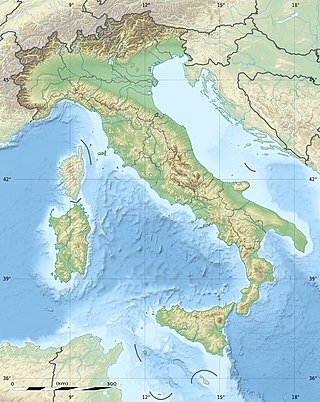
The geography of Italy includes the description of all the physical geographical elements of Italy. Italy, whose territory largely coincides with the homonymous geographical region, is located in southern Europe and comprises the long, boot-shaped Italian Peninsula crossed by the Apennines, the southern side of Alps, the large plain of the Po Valley and some islands including Sicily and Sardinia. Italy is part of the Northern Hemisphere. Two of the Pelagie Islands are located on the African continent.

The Venetian Lagoon is an enclosed bay of the Adriatic Sea, in northern Italy, in which the city of Venice is situated. Its name in the Italian and Venetian languages, Laguna Veneta—cognate of Latin lacus, "lake"—has provided the English name for an enclosed, shallow embayment of salt water, a lagoon.

The Lido, or Venice Lido, is an 11-kilometre-long (7-mile) barrier island in the Venetian Lagoon, Northern Italy; it is home to about 20,400 residents. The Venice Film Festival takes place at the Lido late August/early September.

The Brenta is an Italian river that runs from Trentino to the Adriatic Sea just south of the Venetian lagoon in the Veneto region, in the north-east of Italy.
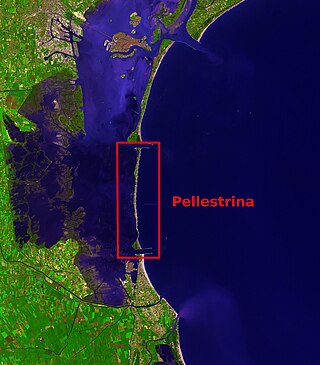
Pellestrina is an island in northern Italy, forming a barrier between the southern Venetian Lagoon and the Adriatic Sea, lying south west of the Lido.

Chioggia is a coastal town and comune of the Metropolitan City of Venice in the Veneto region of northern Italy.
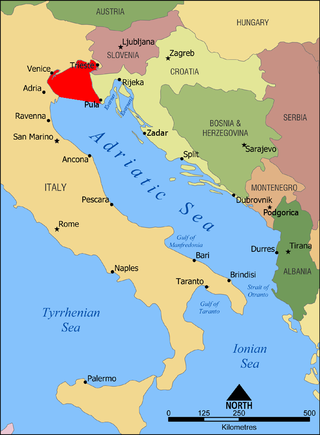
The Gulf of Venice is an informally recognized gulf of the Adriatic Sea. It lies at the extreme north end of the Adriatic, limited on the southwest by the easternmost point of the Po Delta in Italy and on the southeast by the southernmost point of the Istrian Peninsula in Croatia. It is bordered by the coastlines of northeastern Italy and southwestern Croatia and Slovenia.

MOSE is a project intended to protect the city of Venice, Italy, and the Venetian Lagoon from flooding.
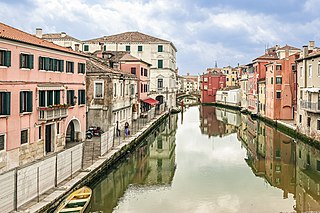
The War of Chioggia was a conflict fought by the Republic of Genoa against the Republic of Venice between 1378 and 1381, the conclusion of an open confrontation that had lasted for years and which had already included some occasional and limited military clashes.

Agnello Participazio was the tenth traditional and eighth (historical) doge of the Duchy of Venetia from 811 to 827. He was born to a rich merchant family from Heraclea and was one of the earliest settlers in the Rivoalto group of islands. His family had provided a number of tribuni militum of Rivoalto. He owned property near the Church of Santi Apostoli. A building in the nearby Campiello del Cason was the residence of the tribunes. Agnello was married to the dogaressa Elena.

Actv S.p.A. is a public company responsible for public transportation in Venice and Chioggia municipalities and for interurban bus services in province of Venice. ACTV is not responsible for Venice People Mover or waterbus routes between airport and the lagoon area. Connections by bus with Venice airport are managed by ACTV and by ATVO.

Dolo is a town and comune in the Metropolitan City of Venice, Veneto, Italy. It is connected by the SP26 provincial road and is one of the towns of the Riviera del Brenta.

Cavarzere is a comune (municipality) in the Metropolitan City of Venice in the Italian region of Veneto, located about 35 kilometres southwest of Venice.
The Via Annia was the Roman road in Venetia in north-eastern Italy. It run on the low plains of the lower River Po and of the lower Veneto and Friuli-Venezia Giulia regions, an area which had many rivers and large marsh areas and bordered the coastal lagoons. It linked Atria to Aquileia, passing through Patavium. Then it got to the mainland coast of the Lagoon of Venice near today's Mestre and passed through Altinum. After this, it went through Iulia Concordia, which was further inland. It was paved only through the main towns. The rest was gravelled. It was six to eighteen metre wide. It played an important part in the Romanization of the region.
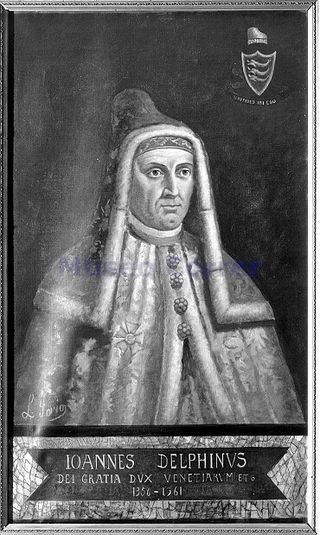
Giovanni Dolfin, also known as Giovanni Delfino or Delfin, was the 57th Doge of Venice from his appointment on 13 August 1356 to his death in 1361. Despite his value as a general, during his reign Venice lost Dalmatia. He was blinded in one eye after a wound received in battle.

Malamocco was the first, and for a long time, the only, settlement on the Lido of Venice barrier island of the Lagoon of Venice. It is located just south of the island's center and it is part of the Lido-Pellestrina borough of the municipality of Venice.
Luigi Steffani (1828–1898) was an Italian painter, mainly of sea and landscapes.
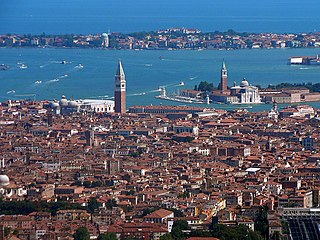
The Metropolitan City of Venice is a metropolitan city in the Veneto region of Italy, one of ten metropolitan cities in Italy. Its capital is the city of Venice. It replaced the province of Venice in 2015 and includes the city of Venice and 43 comuni. It was first created by the reform of local authorities and then established by Law 56/2014. The Metropolitan City of Venice is headed by the Metropolitan Mayor and the Metropolitan Council. Since 15 June 2015, as the new mayor of the capital city, Luigi Brugnaro is the first mayor of the metropolitan city.
Tegnue are rock formations which have developed in the sea bottom of the Gulf of Venice, in the northern Adriatic Sea. They are bio-sediments which are very similar to coral reefs and for this reason they also are called Adriatic coral reefs. They are found especially off the coasts of Caorle, the Cavallino peninsula, the Lido di Venezia island and the Sottomarina peninsula at Chioggia. There are eight such formations. They are at a depth of -15/-40 m. The largest formation is off the coast of the Cavallino peninsula.
Gronda lagunare is a term used to indicate the area of the Lagoon of Venice by its mainland shore. The term is derived from the fact that it receives the waters from the rivers and streams which flow into the lagoon from the drainage basin of the plain of the mainland by the lagoon. It is also reached by the tidal flows form he sea., it is meant to be a belt that forms a transition area between the open lagoon and the mainland.




















